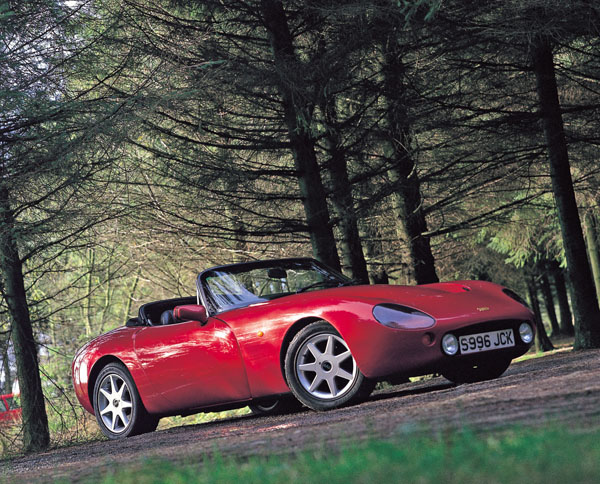
The TVR Griffith is, in many ways, similar to the Porsche Boxster. Whilst it was not the steel-bodied sophisticate, with monocoque body powered by a multi-valve, mid-engined marvel of German engineering this automobile from Blackpool made up in force what it lacked in technology. It had a tubular chassis with a body of plastic and many recognised that the final car was quite phenomenal.
The Griffith was the first of a new generation of TVRs and the one that did more than any other to advance the image from one barely elevated above that of the kit-car builder to the place it now enjoys as a respected constructor of outrageously fast and brutal sportscars. TVR followed the old formula of putting a large and potent engine into the nose of a glassfibre body with a steel spaceframe chassis to produce a very tempting sportscar.
It was powered by a 180 kW pushrod Rover motor in one form. This was the least powerful of the five Rover engine variants offered by the factory in its decade of production, but even with this motor the Griffith was capable of reaching 96 km/h from standstill in less than five seconds, and on to well over 240 km/h. In a straight line the performance was outstanding but when driven on a typical twisting road any comparison with say, a Boxster, was quite a different story through the simple expedient of not having to slow very much for the corners.
The Griffith never approached these standards. Its ride was somewhat stiff and was quite easily upset by camber and surface changes, with a certain amount of steering kickback. It was certainly not good on wet roads even though it came with a GKN limited-slip differential as standard. In spite of these apparent shortcomings the new driver was usually quite surprised at how well the Griffith coped with the kilometres with a tall top gear and low wind noise. Suspension comprised unequal length wishbones, coil springs and anti-roll bar front and rear. Brakes were servo-assisted all round.
No one could say the Griffith was anything other than a proper TVR, one of the best in the company’s history and quite possibly the most attractive. Though its engine would grow through 4.3 and 4.5 litres up to 5.0 litres, the original 4.0-litre motors were by no means poor relations. The earlier models didn’t have catalytic converters and they sounded even better than the later, quicker, 5.0-litre cars.
Rack and pinion steering was used and on the later 5.0-litre models and a power assisted option was offered. While the TVR Griffith could suffer the odd problem this was usually due to dodgy assembly at the factory. Major components such as engine, gearbox, clutch and so on were remarkably strong and not prone to breakdown.
The TVR Griffith certainly was a classic. It was not exactly sophisticated but when it was being driven fast, and with its good looks, it was not hard to have fun driving it. Even the lovely burbling engine noise would make any owner forgive and forget any of its foibles.